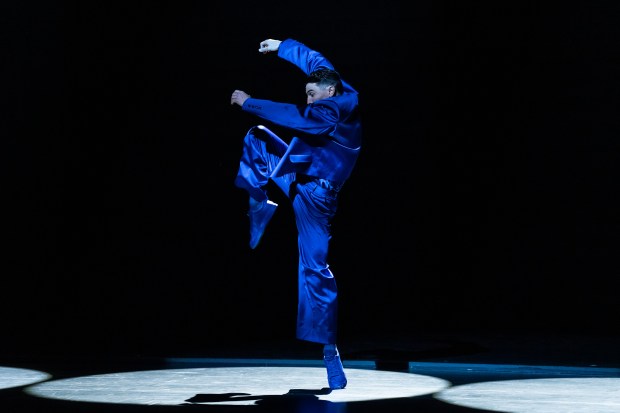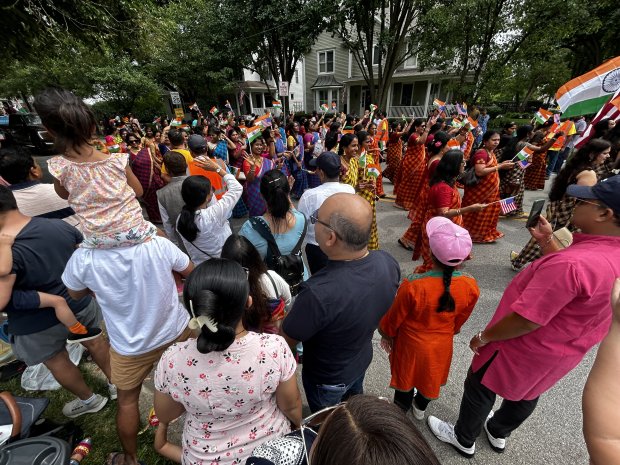Hubbard Street Dance Chicago’s season finale coinciding with Beyoncé’s Chicago dates is perhaps just a happy accident. But as last night’s freaky dust storm tapered off and audiences settled into their seats at the Harris Theater, Bob Fosse and Gwen Verdon’s “Sweet Gwen Suite” was a most poetic opening to the evening.
The third of this trio of juicy morsels created for 1960s television specials is “Mexican Breakfast,” which Beyoncé reimagined in her “Single Ladies” video. It was a move that kicked off an existential conversation about artistic license, inspiration and ownership. She’d do it again in the “Countdown” video. And again in “Lemonade.” (Some say she plagiarized, but it’s deeper than that.)
In their Fall Series at Steppenwolf, we were forced to wait until the show was three-quarters finished to see dancers Cyrie Topete, Dominick Brown and Aaron Choate emerge in silhouette, hats tipped just right, puffs of cigarette smoke perfectly timed, bedazzled charro suits on point — all images now synonymous with Fosse. That program began with resident choreographer Aszure Barton’s contemplative “Return to Patience,” a tease in hindsight. But as a fitting bookend to Hubbard Street’s 47th season, Fosse goes first, making it easy to follow instructions given at the top of every show by artistic director Linda-Denise Fisher-Harrell: “Get your whole life together.”
Here, Barton goes last, with a revival of her 2002 “Blue Soup.” The point is, this program doesn’t creep or simmer, it goes from zero to 60 and pretty much stays there the whole time.
The night’s only world premiere, Matthew Rushing’s “Beauty Chasers,” expands on a section of another of his works called “Sacred Songs.” Rushing created that piece last year as an extrapolation of Alvin Ailey’s “Revelations” — the signature work of the late choreographer’s eponymous company, led by Rushing for the past two years. For it, he excavated spirituals used for the original “Revelations” that got cut as the hour-long ballet was shortened for ease in touring.
Where “Revelations” and “Sacred Songs” express facets of the African American experience, “Beauty Chasers” seems a kind of prequel — opening on Topete (who was simply extraordinary the whole night) in a pool of light, wearing flesh-toned underthings. Shota Miyoshi takes a turn, too, elegantly writhing in his own pool of stark white light, then Bianca Melidor. Rushing has said “Beauty Chasers” loosely references the Holy Trinity from Christianity — the Father, the Son and the Holy Ghost. For me, it’s more like Genesis. In the beginning, there was (designer Jason Lynch’s) light, then man. And then there was jazz. And it was good.
The piece really begins to cook as a recording of Alice Coltrane and Pharoah Sanders’ “Journey to Satchidananda” drops in, a celestial arrangement for keys, flute, bass and drums. The trio of dancers gradually dresses each time they re-enter the scene, increasingly noticing, accepting and literally leaning on one another. “Beauty Chasers’” hybrid score (arranged by sound designer Dante Giramma) and costumer Dante Anthony Baylor’s final look — red, white and black palazzo pants and matching beaded necklaces — beautifully complement Rushing’s blend of modern, afro-contemporary and traditional West African vocabularies. To be sure, it’s something new for Rushing, well outside his comfort zone. Thus, the underbelly feels raw and vulnerable — the rewards worth all the risk.
A one-act behemoth closing the show, “Blue Soup” has many hallmarks of what we’ve come to know of Barton’s catalog, enough to make me wonder if this is where it all started. There’s a signature tension between the literal and the imagined, moments of authenticity layered with sarcasm and vaudevillian veneer. There are just a few clues the piece came early in Barton’s career — mainly in how “Blue Soup” wears its influences on its big, blue, shoulder padded zoot suit sleeves. Created a year after David Lynch’s “Mulholland Drive,” “Blue Soup” borrows images from the film, though not quite as literally as Beyoncé borrowed from “Mexican Breakfast.”
Choate appears alone, a vision in a blonde wig, sky-high stilettos, satiny blue robe and leotard — azure blue. Choate awkwardly lip syncs at an old-timey microphone. It’s “Sh-Boom” by The Chords — a bop, to be sure. It’s far more ridiculous than “Mulholland Drive’s” “this is the girl” screen test, a sort of blending of that and the film’s darker sections. As the lens opens, the full company joins, facing upstage for what seems like a long time until Angelo Badalamenti’s “Jitterbug” drops in — another nod to “Mulholland Drive.”
Admittedly, “Mulholland Drive” is canon to me, a very particular film released as a very particular moment in this critic’s life. I am thus programmed to adore “Blue Soup,” but you needn’t know any of Barton’s tongue-and-cheek references to see how the piece points at the rot underneath the shimmer of Hollywood and the fallibility of a dream. Then there’s all this incredible dancing — highlights too numerous to list, though Choate in that blonde wig is certainly one. Another: Andrew Murdock in a phenomenal solo dancing between four downstage circles of light, a kind of washed-up showman torn between what’s real and what’s imagined. And another: Jacqueline Burnett, back on stage after a long absence as though no time has passed, in the piece’s most authentic moments, joined briefly by Elliott Hammans, who somehow supports her from the exact opposite corner of the stage. Despite a big, rousing group dance set to Paul Simon’s “Pigs, Sheep & Wolves,” complete with unhinged, stomping diversions and a fair amount of well-timed hip thrusts, the piece ends rather unsatisfyingly before the company bows. But fear not, you will leave the theater satisfied.
You see, unlike “Mulholland Drive,” “Blue Soup” is more shimmer than rot, appearing hopeful by comparison — maybe big, rousing group dances just do that. So does text by Maya Angelou (“Sounds Like Pearls” to be exact). Where Lynch gave Barton permission to be weird, Angelou lent optimism.
Lauren Warnecke is a freelance critic.
Review: Hubbard Street Dance Chicago Spring Series (4 stars)
When: Through Sunday
Where: Harris Theater for Music and Dance, 205 E. Randolph St.
Running time: 1 hour, 45 minutes with one intermission
Tickets: $46-$121 at 312-334-7777 and hubbardstreetdance.com




